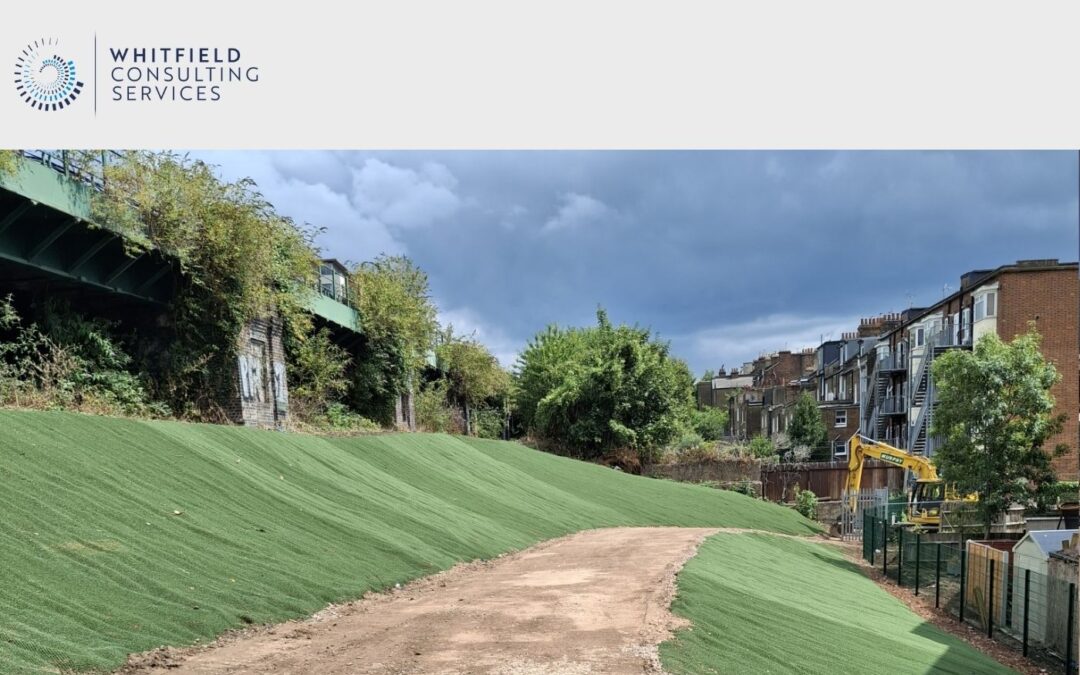Slope stability is critical to the safety, reliability, and longevity of rail networks. As extreme weather events become more frequent owing to climate change, the risks posed by unstable slopes — ranging from service delays to significant infrastructure damage — have intensified.
By combining in-house experience with specialists in geotechnics, monitoring, and environmental engineering, WCS provides practical, cost-effective strategies to mitigate these risks.
In this article, we examine the growing challenges of slope instability, highlight effective interventions, and explore how WCS’s proven track record aligns with the priorities of Control Period 7 (CP7) and beyond.
The growing challenge of slope stability
“As the rail industry continues to adapt to the challenges of climate change, slope stability must be a central focus,” says Jeremy Barnes, Technical Director, who oversees the stability operations at WCS.
The rail network is increasingly vulnerable to slope instability. Heavy rainfall and prolonged wet periods saturate soils, raising pore water pressure and weakening embankments. These conditions lead to landslides, erosion, and in some cases, catastrophic failures such as the Stonehaven derailment.
“These failures are exacerbated by the fact that much of our infrastructure, including embankments, was built a long time ago, often using older materials and techniques that were not designed to withstand today’s weather extremes,” says Nick Slater, an instrumentation and monitoring specialist.
Network Rail recognises these challenges and has committed £2.8bn over the next five years in activities and technology that will help the UK’s railways better cope with extreme weather events.
“Proactive management and robust infrastructure design are essential to ensuring resilience, safety, and an uninterrupted rail service,” adds Jeremy.
Learn more about the effect of extreme weather on civil engineering design.
The impact of flooding and progressive weakening
Flooding is one of the most significant contributors to slope instability. Flood alerts reached a record level in Great Britain in the first four months of 2024.
“Heavy rain and flooding increase pore water pressure within the soil, reducing its strength and cohesion,” explains Nick. “This infiltration can lead to sudden slope failures during storms or prolonged periods of heavy rainfall.”
Rainwater also causes long-term damage by accelerating erosion. “Over time, with continued wetting and drying processes, cracks can form in embankments, allowing water to penetrate and degrade the structure further. Areas once considered low risk, such as the Basingstoke slip, are now increasingly vulnerable to failure,” adds Nick.
“Flood risk is a specialist field,” says Jeremy, “WCS has engineers who work regularly in this area across infrastructure projects in Rail and Power & Energy projects, consulting on flood mitigation and providing their expertise.”
The value of early intervention
Under the CP7 framework, Network Rail has noted slope stability as a priority alongside drainage monitoring and earthworks. This proactive focus seeks to mitigate risks through enhanced inspections, targeted reinforcements, and leveraging technological advancements such as:
- Remote Condition Monitoring (RCM): Use of surface mounted, wireless tilt sensors on posts can provide near real-time data and notifications of event detection when a slope failure occurs. Using in-ground sensing of pore pressures, lateral and vertical displacements provide data to inform long term condition monitoring and deterioration rates, helping to inform stakeholders when failures occur, but also to detect precursors to slope failure enabling early intervention of any remedial work or mitigation measures.
- Drone surveys: High-resolution aerial surveys allow for comprehensive, efficient inspections, even in hard-to-reach areas.
- Predictive modelling: Advanced computer models simulate embankment responses to weather events, allowing pre-emptive interventions in high-risk zones.
Speaking about the Basingstoke slip, Jeremy says:
“The impact of insufficient mitigation can be catastrophic. The landslip between London and Basingstoke occurred after prolonged heavy rainfall saturated the ground, leading to a collapse. This resulted in train cancellations during the repair period, which was disruptive enough. However, had the failure occurred while a train was passing, the consequences could have been far graver, potentially involving loss of life. This is why we adopt a precautionary approach, factoring in the risks posed by extreme weather conditions.”
Effective strategies for resilience: WCS in action
Mitigating slope instability begins with proper drainage design and maintenance. Techniques like soil nailing, geogrid reinforcement, and retaining walls fortify slopes against movement, while vegetation management balances soil stability with water flow control. Case studies highlight the value of these approaches:
Case study: addressing the structural failure of an ageing retaining wall in West Hampstead
WCS was appointed to design the removal of a deteriorating red brick retaining wall in Netherwood Street, West Hampstead, which had developed structural defects, including leaning and fracturing, posing a serious risk to public safety. Commissioned by Network Rail, with Murphy as the direct client, the project aimed to improve safety and stability by replacing the wall with a sustainably designed regraded slope and new boundary fence – all while minimising disruption to the public and nearby railway operations. The new slope design reduced the retained height and incorporated an environmentally friendly EnkaMat erosion control system, which will be seeded to promote long-term stability.
Key project components included comprehensive topographical and geotechnical surveys, a slope stability model developed using CADS Geotechnical software, and a construction methodology that eliminated the need for costly soil anchors. Additionally, a 3.5m-wide access track was integrated into the slope to ensure ongoing accessibility across the site.
Case study: retaining wall stabilisation at the Ipswich Depot
As part of Murphy’s Civil Asset Maintenance (CAM) – Anglia region framework for Network Rail, WCS was asked to attend site and provide a design solution to relieve pressure on a section of existing reinforced concrete retaining wall separating the track from private homeowners’ property.
After assisting our client with specifications for ground investigations, monitoring and intrusive surveys of the retaining wall itself, we provided a detailed design for the installation of sheet piles in a restricted site and under a tight possession. This relieved pressure on the wall and ensured ongoing stability and facilitated the reopening of the adjacent depot Permanent Way.
Collaboration for long-term success
With a proven track record in rail projects, WCS offers a comprehensive approach to slope stability. By combining in-house expertise with trusted external partners, WCS delivers tailored solutions that prioritise prevention, cost efficiency, and operational safety.
“We believe a collaborative approach allows us to offer the best value and quality of solution,” says Jeremy.
“Collaboration and embracing new technologies are central to our work on slope stability,” agrees Nick. “Together, we bring strength by pooling knowledge, which enables us to address challenges from multiple angles, especially when planning long-term infrastructure resilience.”
Slope stability: a call to action
“Network Rail manages 10,000 miles of track and several times as many rail journeys as many larger countries. The scale and diversity of conditions across the network, and of infrastructure that can be well over 100 years old, mean finding solutions in the rail sector requires a creative approach to overcoming challenges,” says Jeremy.
WCS is committed to supporting the UK’s transition to a more resilient and sustainable rail network.
“Our proven track record in delivering civil engineering solutions for significant infrastructure projects means we’re well-placed to support the delivery of railway frameworks,” adds Jeremy.
To find out what that expertise can deliver on your next project, please get in touch at (0)20 3581 7847, info@wcs-consult.co.uk, or via our contact page.

